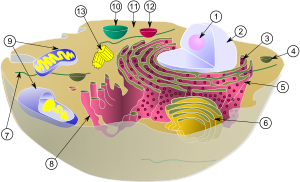
biology and environment
biology and environment
biology and environment
biology and environmentStructural
ces between cell types are particularly relevant to molecular biology.
Anatomy considers the forms of macroscopic structures such as organs and organ systems.]
Genetics is the science of genes, heredity, and the variation of organisms. Genes encode the information necessary for synthesizing proteins, which in turn play a central role in influencing the final phenotype of the organism. In modern research, genetics provides important tools in the investigation of the function of a particular gene, or the analysis of genetic interactions. Within organisms, genetic information generally is carried in chromosomes, where it is represented in the chemical structure of particular DNA molecules.
Developmental biology studies the process by which organisms grow and develop. Originating in embryology, modern developmental biology studies the genetic control of cell growth, differentiation, and "morphogenesis," which is the process that progressively gives rise to tissues, organs, and anatomy. Model organisms for developmental biology include the round worm Caenorhabditis elegans, the fruit fly Drosophila melanogaster, the zebrafish Danio rerio, the mouse Mus musculus, and the weed Arabidopsis thaliana.(A model organism is a species that is extensively studied to understand particular biological phenomena, with the expectation that discoveries made in that organism provide insight into the workings of other organisms.)]
Homeostasis
To maintain dynamic equilibrium and effectively carry out certain functions, a system must detect and respond to perturbations. After the detection of a perturbation, a biological system normally responds through negative feedback. This means stabilizing conditions by either reducing or increasing the activity of an organ or system. One example is the release of glucagon when sugar levels are too low.

Energy
The survival of a living organism depends on the continuous input of energy. Chemical reactions that are responsible for its structure and function are tuned to extract energy from substances that act as its food and transform them to help form new cells and sustain them. In this process, molecules of chemical substances that constitute food play two roles; first, they contain energy that can be transformed for biological chemical reactions; second, they develop new molecular structures made up of biomolecules.
The organisms responsible for the introduction of energy into an ecosystem are known as producers or autotrophs. Nearly all of these organisms originally draw energy from the sun.Plants and other phototrophs use solar energy via a process known as photosynthesis to convert raw materials into organic molecules, such as ATP, whose bonds can be broken to release energy.A few ecosystems, however, depend entirely on energy extracted by chemotrophs from methane, sulfides, or other non-luminal energy sources.[38]
Some of the captured energy is used to produce biomass to sustain life and provide energy for growth and development. The majority of the rest of this energy is lost as heat and waste molecules. The most important processes for converting the energy trapped in chemical substances into energy useful to sustain life are metabolism and cellular respiration.]
